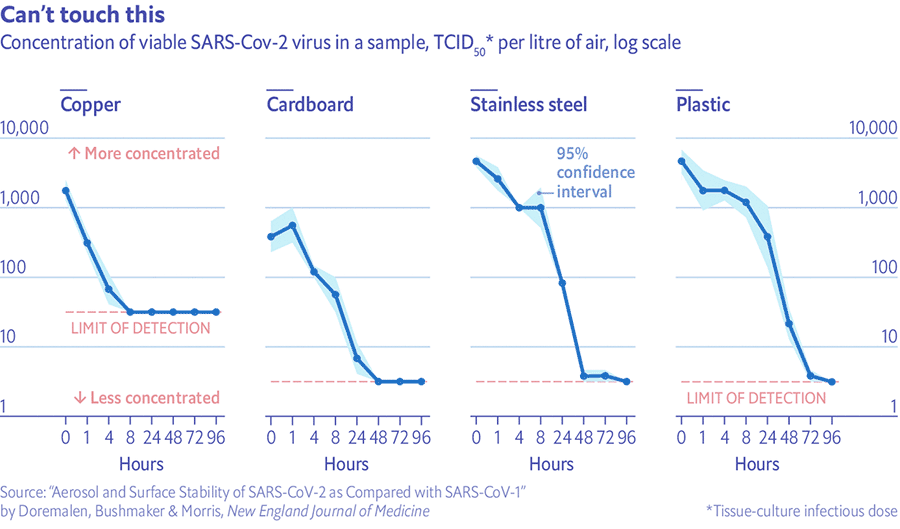Do you know the answers to these questions?
1. How long should you wait before you touch your delivery boxes?
2. How long does an infected sneeze or cough hover in the air?
How stable is the COVID-19 virus?
Up until 4 days ago, the World Health Organization referred to the virus as not being airborne,[1]WHO considers ‘airborne precautions’ for medical staff after study shows coronavirus can survive in air | CNBC but this study and a second one[2]Aerodynamic Characteristics and RNA Concentration of SARS-CoV-2 Aerosol in Wuhan Hospitals during COVID-19 Outbreak (Liu et al., 2020) show that transmission of the virus through the air is possible in some settings.
On Tuesday, March 17 in the New England Journal of Medicine, shows that:[3]Aerosol and Surface Stability of SARS-CoV-2 as Compared with SARS-CoV-1 (Doremalen et al., 2020)
Aerosol transmission
- After sneezing, the COVID-19 virus (SARS-CoV-2) stays suspended for 30 minutes and then drifts down.
- Once landed on a surface it can last for many hours.
- Everything at the grocery store and restaurant takeout containers and bags could have the virus on them, so wipe down packages with disinfectant wipes and wash your hands before putting them away in the cupboard.
A second study, published on March 10, also shows that:[4]Aerodynamic Characteristics and RNA Concentration of SARS-CoV-2 Aerosol in Wuhan Hospitals during COVID-19 Outbreak (Liu et al., 2020)
-
- Gathering of crowds with carriers is a potential source of airborne SARS-CoV-2.
- SARS-CoV-2 on protective apparel or floor surface (and their subsequent resuspension) is a potential transmission pathway.
- Effective sanitization is critical in minimizing the transmission of SARS-CoV-2 through the air.
In practical terms: At 1:00 pm Bob (who unknowingly has COVID-19) goes to the grocery store and sneezes in the bread aisle. At 1:15 pm Sarah seeing the bread aisle is free from other people, confidently goes to get bread. Unknowingly she walks through the viral air-suspended droplets. Now Sarah likely has COVID-19 too.
SARSy surfaces
- Steel/plastic — SARS-CoV-2 lasts 72 hours on plastic and steel, but the ability to infect decreases drastically during this time.
- Cardboard — SARS-CoV-2 disintegrates over the course of 24 hours on cardboard unless a person has coughed, handled it with contaminated hands, or sneezed on it.
- Copper — SARS-CoV-2 lasts only 4 hours on copper.
In practical terms:
Scenario 1: At 1:00 pm Friday, Sam (who unknowingly has COVID-19) drops off a package in a cardboard box at June’s house. Even if Sam is wearing gloves but touches his face or another surface contaminated with the virus, he will transfer the virus to June’s delivery.
At 1:15 pm Friday, June seeing the delivered box, confidently picks it up with her hands. She has now been exposed to the virus. If she touches her face or any other surface, June will transfer the virus to that surface.
Scenario 2: At 1:15 pm Friday, June sees the COVID-19 contaminated delivered box and confidently picks it up wearing a fresh pair of gloves. She has now exposed her gloves to the virus. If she touches her face or any surface with her gloves, June will transfer the virus to that surface. In addition, any surface June places the box on may now be contaminated with the virus.
However, if she carefully removes her gloves and disposes of them properly, she will not be exposed to the virus. In order to avoid viral exposure, June must leave the box untouched for 24 hours. After 24 hours she can open the box without gloves. But what about the surface where she placed the box? The surface is now contaminated. If the surface is metal or plastic, the virus can survive another 48 hours (totalling 72 hours).
Scenario 3: After 24 hours June carefully opens the box and removes her plastic-covered items. The items were put in the box 48 hours ago which means despite the box now being safe, the items continue to remain contaminated for another 12 hours (totalling 72 hours).

Comments
Let us know what you think!